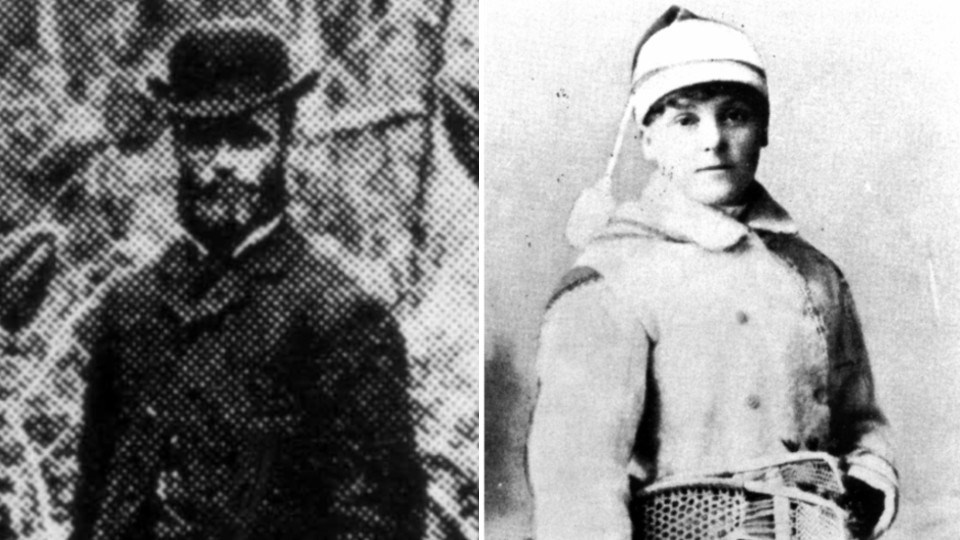Florence Ward fell in love with her future husband, William Howey, when she was a young girl in Delhi (Del-high), a farming community in the heart of tobacco country in southwestern Ontario.
Florence and William were schoolmates. She was obviously impressed with the smart and handsome young man who had plans to attend medical school. He was smitten as well.
Despite the allure of Montreal, the couple became engaged after his first year at McGill University. In 1878, when he graduated at the age of 22 with degrees in medicine and surgery, he came back to Delhi and married his high school sweetheart.
Florence looked forward to a quiet life as the wife of a small-town doctor. She probably never imagined their lives would be full of adventure in the wilds north of the French River.
The Howeys are considered the first pioneer settlers in Sudbury, arriving just a few months after CPR rail crews blasted through Sudbury Junction in 1883. Florence's book, “Pioneering on the CPR”, written in 1933, is considered an important source of local history.
William practised in Norfolk County for four years. But, according to Florence, residents in the area favoured the care of the older, established doctors. Canadian Pacific Railway advertised for a doctor to look after employees in the northeast. The pay was $75 a month with a house. William, with his wife's blessing, applied for the job.
"I was game for the adventure, thinking it would be for only a little while, and I agreed, so the application went in. This was early in December 1882. Just before Christmas an answer came, brief but thrilling, a wire, 'Report for duty at Mattawa at once!' “
In Florence's mind, northeastern Ontario was a frozen, howling wilderness.
"Owen Sound and Parry Sound were about the limit of habitable territory. We regarded the Soo and Manitoulin Island as being pretty well up towards the North Pole. What then would it be like north of Lake Nipissing?"
Florence remained in Delhi until March 1883 when William sent for her to join him. A woman travelling alone anywhere, let alone to the wilderness, was unusual. She travelled from her home by train to Hamilton, where she transferred to another train to Brockville. There, she boarded the Canada Central to Pembroke.
"My husband met me at Pembroke and the remainder of the journey to Mattawa was made in a flat car with seats, attached to a construction train. It was cold and slow with many stops and I was tired and miserable, only the delight of being reunited kept my spirit up."
As railroad construction crews headed west, the Howeys settled for a few months near Sturgeon Falls. In July 1883, they arrived in Sudbury and moved into the log house promised by the CPR, which was located at Elm and Lorne streets.
"There was nothing here then except a small camp and stable, built for the men and horses of an advance gang which was to be sent in to cut out the right of way for the railroad. It was situated in a clearance of about half an acre of ground at 158 Elm St. E."
CPR built a small hospital near the Howey home for its workers engaged in the dangerous logging and rail construction. The area was soon dubbed "Pill Hill."
Florence was not a nurse, but out of necessity she often assisted her husband.
"There were plenty of frozen ears and toes, some of them had to be amputated, and for those and fractures I had to administer the anesthetic. Poor doctor was obliged to watch me and the patient as well as attend to his work in hand. It was a good thing that I was not given to fainting at the sight of blood.
"There was no provision for sanitation, ventilation or any other of the many ‘-ations’ provided nowadays, and considered indispensable. I do think my boy doctor performed miracles under the conditions."
The Howeys, a childless couple, were friends of Thomas Ross, who was employed at the Hudson's Bay outpost near Naughton. In January 1886, Dr. Howey attended the delivery of Ross’ ninth child with his wife, Marguerite. Arthur Howey Ross (of the Art Ross Trophy), hockey player and NHL team executive, got his middle name from his godmother, Florence.
William worked long hours, was often away from home, and was tired when he came home. Florence never complained about roughing it in the bush, at least not in her book, maintaining a curiosity about her new community and remaining cheerful about the challenges.
For a short time, she kept a baby cub as a pet, and records Dr. Howey, as she usually referred to her husband, received a present of "twin baby moose," from the Indigenous community.
"We had no place to keep them during the winter so the doctor advertised them for sale. A New York firm answered the advertisement, offering $200 for them, so they were sent away. I was very sorry we could not keep them, they were about eight months old then. We received word they were sold to a Russian nobleman, to train for driving. I hoped he would be kind to them, they were very tame and had always been petted."
Watch for more about the Howeys on Jan. 28.
Vicki Gilhula is a freelance writer. She is a former editor of Northern Life and Sudbury Living magazine, and has a special interest in local history. Memory Lane is made possible by our Community Leaders Program.
